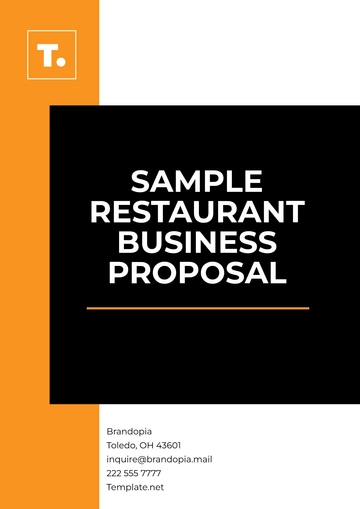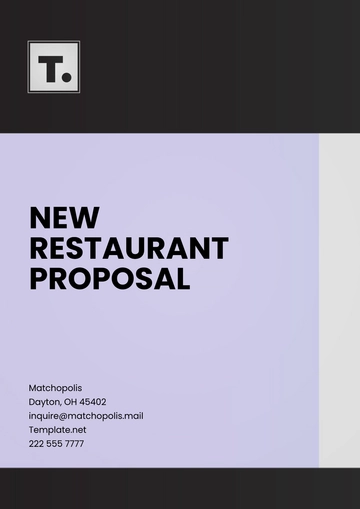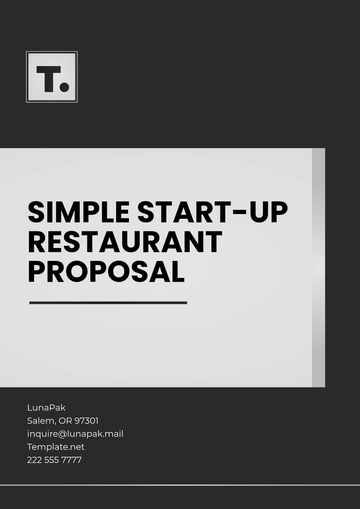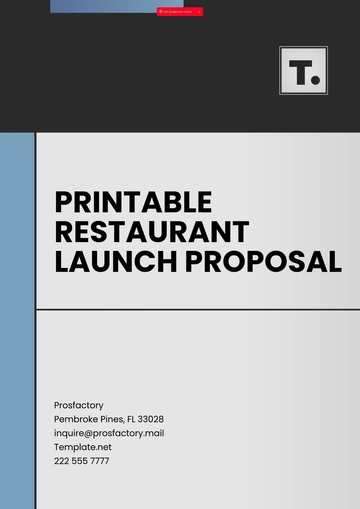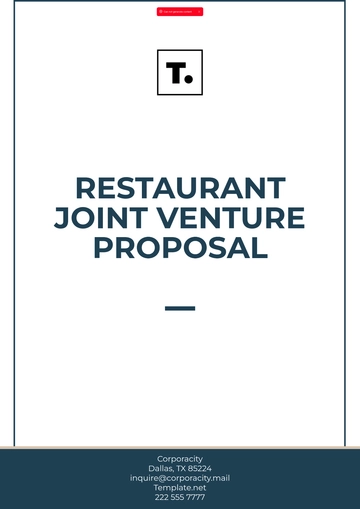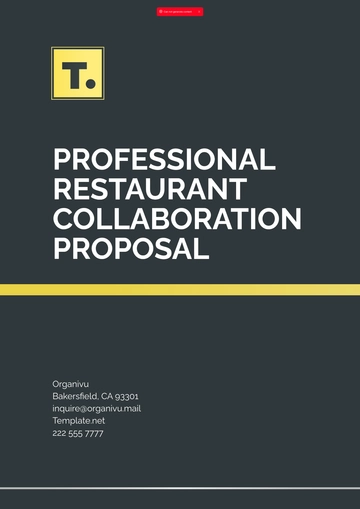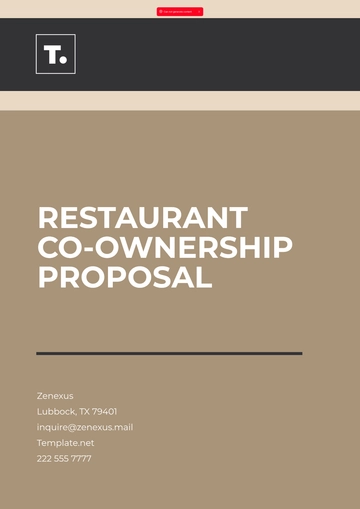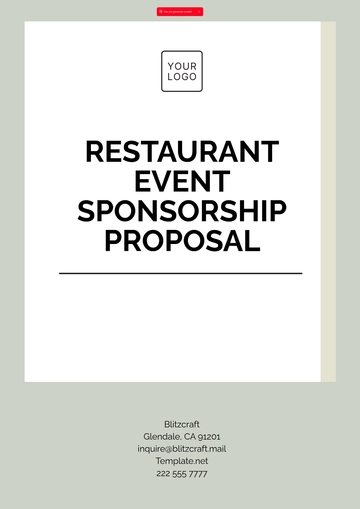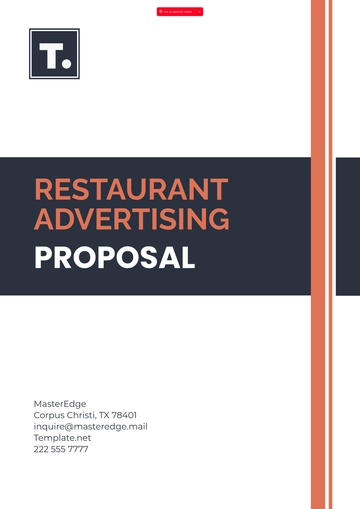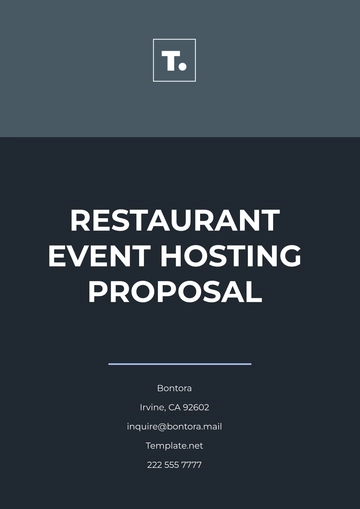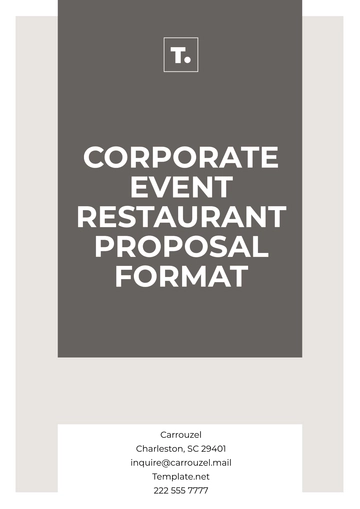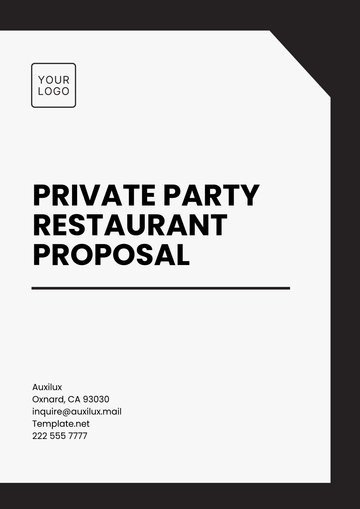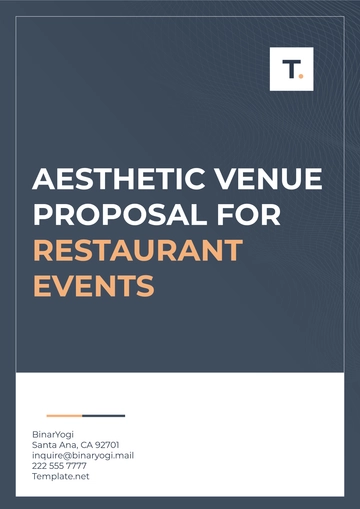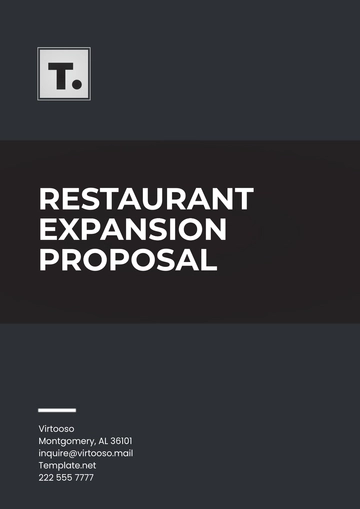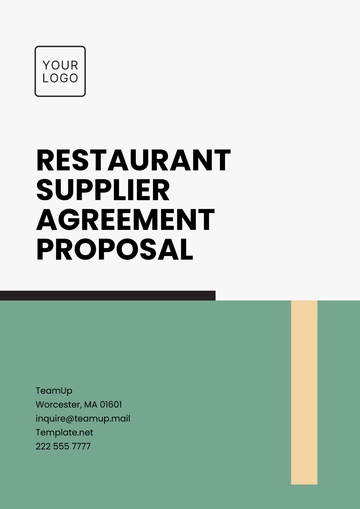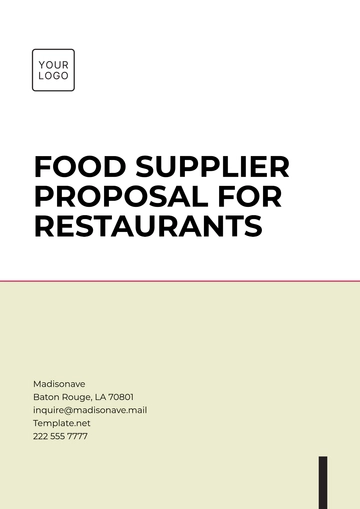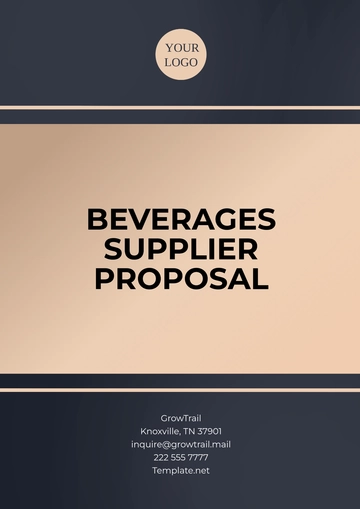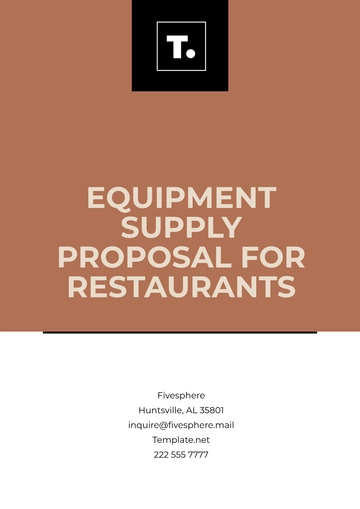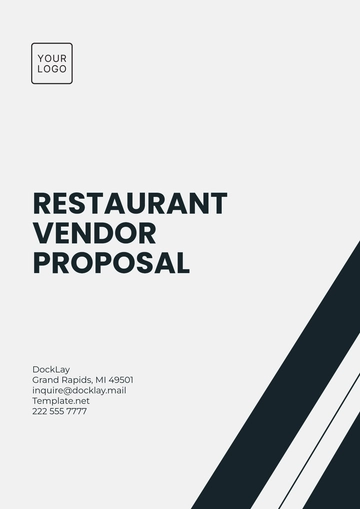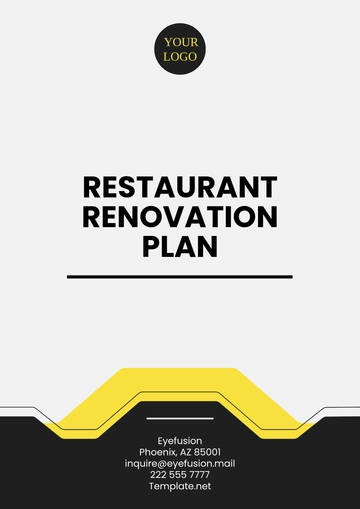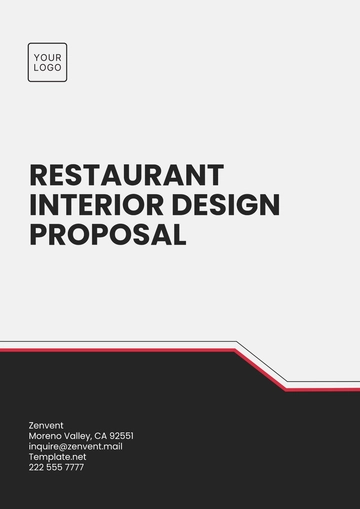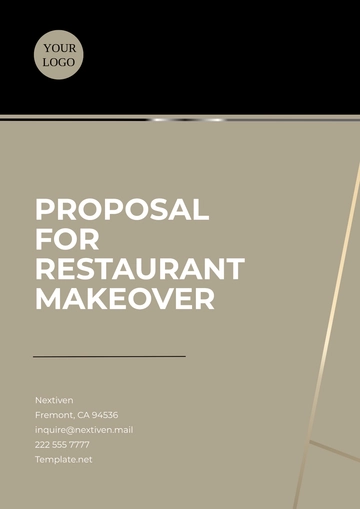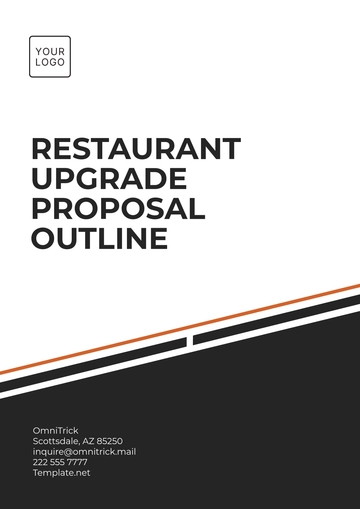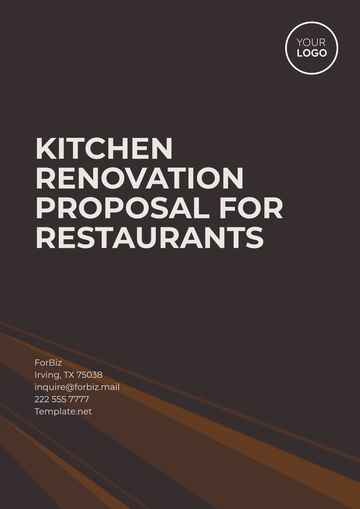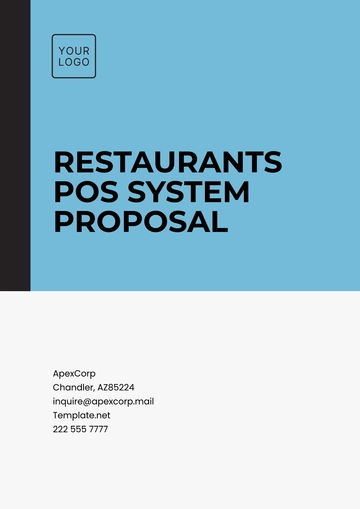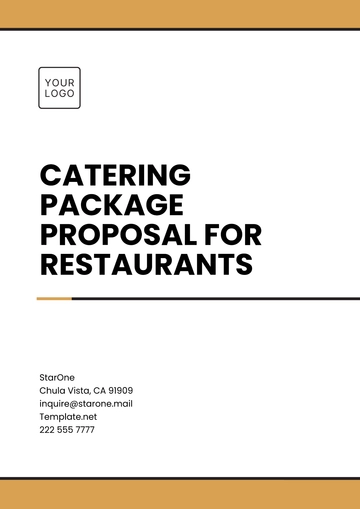Free Restaurant Proposal

Prepared by: [Your Name]
Company: [Your Company Name]
Date: [Insert Date]
I. Executive Summary
The proposed development of a new restaurant under [Your Company Name] is a strategic initiative designed to tap into the growing demand for quick, tasty, and affordable meals. The restaurant aims to cater to a diverse clientele, with a focus on both traditional and health-conscious consumers. Our key focus areas include creating a menu that appeals to a wide range of tastes, implementing robust marketing strategies to build brand awareness and customer loyalty, and ensuring operational excellence to deliver high-quality food and service.
The food industry continues to grow, driven by changing consumer lifestyles and the increasing demand for convenience. With a strategic location, an innovative menu, and effective marketing tactics, [Your Company Name] is well-positioned to capitalize on these trends and achieve significant market penetration. The total budget for this venture is estimated to be $390,000, which has been carefully allocated to cover all aspects of the restaurant’s development and operation.
The project is planned to be executed in phases over a period of 7.5 months to minimize disruption to ongoing operations. This timeline ensures that each phase of the project receives the attention it requires and that the project progresses in a systematic and efficient manner. We believe that these elements are crucial to establishing a successful food restaurant and look forward to bringing this exciting venture to life.
II. Objectives
The main objectives of this venture include:
A. Location Opening
Our immediate goal is to open the first location within the next 12 months. This will serve as the flagship restaurant for [Your Company Name] and will set the standard for future locations. We believe that a successful launch of our first location will not only establish our brand in the market but also provide valuable insights and experience that can be applied to subsequent locations.
B. Revenue Target
We aim to achieve a monthly revenue target of $50,000 within the first six months of operation. This ambitious yet achievable target reflects our confidence in the appeal of our menu, the effectiveness of our marketing strategies, and the potential of the location. Achieving this target will be a significant milestone that demonstrates the viability and profitability of our business model.
C. Business Model
We plan to develop a sustainable and scalable business model that can be replicated in future locations. This involves optimizing our operations for efficiency, building strong relationships with suppliers, and creating a workplace culture that attracts and retains high-quality staff. Our business model will also emphasize adaptability, allowing us to respond quickly to changes in the market or customer preferences.
D. Brand Presence
Another key objective is to establish a strong brand presence in the local market. We plan to achieve this through a combination of excellent customer service, consistent and high-quality food, and effective marketing. By building a strong brand, we aim to differentiate ourselves from competitors and build customer loyalty.
E. Customer Satisfaction
Lastly, but most importantly, we aim to achieve high customer satisfaction rates. We believe that satisfied customers are our best marketers. Word-of-mouth recommendations from happy customers can significantly boost our reputation and attract new customers. Therefore, we will strive to exceed customer expectations in every aspect of their dining experience, from the food and service to the ambiance and value for money.
III. Market Analysis
The food industry is a dynamic and competitive market. To navigate this landscape effectively, we have conducted a detailed SWOT analysis of [Your Company Name]. The following table presents the strengths, weaknesses, opportunities, and threats for our proposed food restaurant:
Strengths | Weaknesses |
|---|---|
Strategic Location | High Initial Investment |
Diverse Menu Options | High Competitive Market |
Opportunities | Threats |
|---|---|
Growing Market Demand | Economic Variability |
Technological Advancements | Changing Consumer Preferences |
A. Strengths
Our strengths lie in our strategic location and diverse menu options. The strategic location of our restaurant will make it easily accessible to a large customer base. Additionally, our diverse menu options will cater to a wide range of tastes and dietary preferences, making our restaurant a preferred choice for many customers. These strengths provide us with a competitive edge in the market.
B. Weaknesses
Despite our strengths, we acknowledge certain weaknesses such as the high initial investment required for setting up the restaurant and the highly competitive nature of the food market. We plan to mitigate these weaknesses through careful financial planning and by implementing robust marketing strategies to stand out in the competitive market.
C. Opportunities
The growing market demand for food and advancements in technology present significant opportunities for our restaurant. The growing market demand validates the potential for the success of our restaurant. Technological advancements, such as online ordering and delivery apps, provide us with new ways to reach and serve our customers.
D. Threats
However, we are also aware of threats such as economic variability and changing consumer preferences. Economic variability can impact consumer spending patterns while changing consumer preferences can influence food trends. We plan to navigate these threats by staying adaptable and responsive to market changes.
The SWOT analysis provides valuable insights that will guide our strategic planning and decision-making process. By understanding our strengths and weaknesses, we can leverage our advantages and address our areas of improvement. By recognizing the opportunities and threats in our external environment, we can strategically position ourselves for success in the food market.
Moreover, this analysis underscores the importance of continuous market analysis and adaptability. The food industry is dynamic, with changing consumer preferences and competitive dynamics. Therefore, staying attuned to these changes and being able to adapt quickly will be key to our success.
IV. Marketing Strategy
A. Social Media Campaign
Brand Awareness: We plan to launch a social media campaign to build brand awareness and engage with potential customers. This campaign will involve regular posts showcasing our menu items, special offers, and behind-the-scenes glimpses into our restaurant. By engaging with our audience on social media, we can build a community around our brand and foster customer loyalty.
Customer Engagement: In addition to raising brand awareness, our social media campaign will also serve as a platform for customer engagement. We will encourage customers to share their dining experiences, post reviews, and interact with our posts. This two-way communication will help us understand our customers better and tailor our offerings to their preferences.
B. Website and Online Ordering System
User-Friendly Website: We plan to create a user-friendly website with an online ordering system. The website will be designed to reflect our brand identity and provide all the necessary information about our restaurant, including our menu, location, and operating hours.
Online Ordering System: The online ordering system will offer a convenient option for customers who prefer to enjoy our food at home. It will be easy to use and will feature real-time updates on order status to ensure a smooth customer experience.
C. Loyalty Programs
Customer Retention: Implementing loyalty programs is another key initiative in our marketing strategy. These programs will reward repeat customers with discounts, free items, or other perks. By offering tangible benefits for repeat business, we can encourage customer loyalty and increase our repeat customer rate.
Customer Acquisition: Loyalty programs can also aid in customer acquisition. Existing customers are more likely to recommend our restaurant to others if they can earn rewards for referrals. Thus, our loyalty program will not only retain existing customers but also attract new ones.
D. Local Partnerships
Community Engagement: We plan to partner with local businesses and schools for promotions. This will not only increase our visibility in the local community but also foster a sense of community involvement.
Mutually Beneficial Partnerships: These partnerships will be mutually beneficial, providing exposure for our partners while attracting a diverse clientele to our restaurant.
V. Financial Plan
Our financial plan is a critical component of our proposal, providing a detailed projection of the expenses and revenue associated with the operation of our food restaurant. The following chart and table outline these financial details:
Category | Amount |
|---|---|
Startup Costs | $150,000 |
Monthly Operating Expenses | $20,000 |
Projected Monthly Revenue | $30,000 |
Total Investment Required | $390,000 |
A. Startup Costs
The startup costs, estimated at $150,000, represent the initial investment required to establish the restaurant. This includes expenses such as leasehold improvements, purchasing kitchen equipment, acquiring initial inventory, and other necessary startup costs. These are one-time costs that are essential to getting the restaurant up and running.
B. Monthly Operating Expenses
The monthly operating expenses, estimated at $20,000, include all the recurring costs associated with running the restaurant. This includes rent, utilities, salaries, food costs, and marketing expenses. These costs are ongoing and will directly impact our bottom line.
C. Projected Monthly Revenue
The projected monthly revenue, estimated at $30,000, is based on our sales forecasts. These forecasts take into account factors such as our pricing strategy, estimated customer traffic, and average spending per customer. Achieving this revenue target is crucial for our financial sustainability.
D. Total Investment Required
The total investment required for this venture, including both the startup costs and the operating expenses for the 12 months, is estimated to be $390,000.
The financial plan is a critical component of our restaurant proposal. It provides a clear picture of the financial requirements and potential returns of the venture. By carefully managing our expenses and striving to meet our revenue targets, we can ensure the financial viability of the restaurant.
Moreover, this financial plan underscores our commitment to financial prudence and sustainability. We understand the importance of managing our finances effectively to ensure the long-term success of our restaurant. Through careful financial planning and management, we aim to deliver a high-quality dining experience to our customers while also achieving our financial objectives.
VI. Operations Plan
A. Workflow
Order Taking: The first step in our workflow is order taking. Our staff will be trained to take orders accurately and quickly, ensuring that customers don’t have to wait long to place their orders. We will also implement a point-of-sale system to streamline this process and reduce errors.
Food Preparation: Once an order is taken, it is passed on to the kitchen. Our kitchen staff will be trained to prepare meals quickly without compromising on quality. We will also implement strict food safety protocols to ensure that all meals are prepared in a hygienic environment.
Order Delivery: The final step in our workflow is order delivery. Whether customers choose to dine in or take away, we will ensure that their orders are delivered promptly. For dine-in customers, we will provide a comfortable and clean dining environment.
B. Staffing
Recruitment: We plan to recruit a team of dedicated and skilled staff who share our commitment to providing excellent customer service. This includes front-of-house staff who interact directly with customers, as well as kitchen staff who prepare the meals.
Training: All staff will undergo comprehensive training to ensure they are equipped with the skills and knowledge required to perform their roles effectively. This includes training in customer service, food safety, and our restaurant’s policies and procedures.
Management: Our management team will be responsible for overseeing the restaurant’s operations, managing staff, and ensuring customer satisfaction. They will also play a key role in implementing our marketing strategies and managing our financial resources.
C. Daily Management
Opening Procedures: Each day will begin with opening procedures such as cleaning the restaurant, preparing the kitchen, and setting up the dining area. These procedures ensure that we are ready to serve customers as soon as we open our doors.
Service: Throughout the day, we will focus on providing excellent service to our customers. This includes taking orders, preparing meals, and addressing any customer concerns or complaints.
Closing Procedures: At the end of the day, we will carry out closing procedures such as cleaning the restaurant, restocking supplies, and preparing for the next day. These procedures ensure that we maintain a clean and organized environment.
VII. Timeline
The timeline for our food restaurant project is a critical component that outlines the duration and sequence of key activities. The following table presents a detailed timeline for the project:
Phase | Duration |
|---|---|
Planning and Design | 2 Months |
Permit and License Acquisition | 1 Month |
Construction and Renovation | 3 Months |
Hiring and Training Staff | 1 Month |
Soft Opening | 2 Weeks |
Official Opening | Day 1 |
Total Project Duration | 7.5 Months |
A. Planning and Design
The planning and design phase, estimated to last 2 months, involves finalizing the restaurant concept, creating the menu, and designing the restaurant layout. This phase is crucial as it sets the foundation for the entire project.
B. Permit and License Acquisition
The permit and license acquisition phase, estimated to last 1 month, involves obtaining all necessary permits and licenses required to operate a restaurant. This includes health permits, building permits, and business licenses.
C. Construction and Renovation
The construction and renovation phase, estimated to last 3 months, involves transforming the chosen location into our restaurant. This includes construction work, installation of kitchen equipment, and interior decoration.
D. Hiring and Training Staff
The hiring and training staff phase, estimated to last 1 month, involves recruiting suitable staff for our restaurant and providing them with the necessary training. This ensures that our team is ready to provide excellent service from day one.
E. Soft Opening
The soft opening, estimated to last 2 weeks, is a period where we operate the restaurant on a limited scale. This allows us to test our operations, gather feedback, and make necessary adjustments before the official opening.
F. Official Opening
The official opening marks the start of our restaurant’s operations. This is when we open our doors to the public and start serving our customers.
G. Total Project Duration
The total project duration is estimated to be 7.5 months. This timeline ensures that each phase of the project receives the attention it requires and that the project progresses systematically and efficiently.
This timeline reflects our commitment to transparency and efficient project management. By breaking down the project into phases, we can focus on each aspect of the restaurant’s development in detail, ensuring high-quality results. Through careful planning and regular progress reviews, we aim to keep the project on track and deliver a restaurant that meets our objectives and exceeds our customers’ expectations.
VIII. Conclusion
The proposed food restaurant under [Your Company Name] represents a strategic venture designed to tap into the growing demand for quick, tasty, and affordable meals. With a comprehensive plan covering everything from our unique menu to our robust marketing strategies and efficient operations, we are well-positioned to establish a strong presence in the food market.
Our commitment to providing excellent customer service, maintaining high food quality, and creating a comfortable dining environment sets us apart from our competitors. We are confident that our food restaurant will not only meet but exceed customer expectations, driving customer loyalty and repeat business. We look forward to bringing this exciting venture to life and delivering an exceptional dining experience to our customers.
- 100% Customizable, free editor
- Access 1 Million+ Templates, photo’s & graphics
- Download or share as a template
- Click and replace photos, graphics, text, backgrounds
- Resize, crop, AI write & more
- Access advanced editor
Present your fast food restaurant proposal effectively with the Fast Food Restaurant Proposal Template! Available on Template.net, this editable template can be tailored to your specific needs. The customizable sections, combined with the AI Editor Tool, help you create a professional and persuasive proposal that clearly outlines your business plans!
You may also like
- Business Proposal
- Research Proposal
- Proposal Request
- Project Proposal
- Grant Proposal
- Photography Proposal
- Job Proposal
- Budget Proposal
- Marketing Proposal
- Branding Proposal
- Advertising Proposal
- Sales Proposal
- Startup Proposal
- Event Proposal
- Creative Proposal
- Restaurant Proposal
- Blank Proposal
- One Page Proposal
- Proposal Report
- IT Proposal
- Non Profit Proposal
- Training Proposal
- Construction Proposal
- School Proposal
- Cleaning Proposal
- Contract Proposal
- HR Proposal
- Travel Agency Proposal
- Small Business Proposal
- Investment Proposal
- Bid Proposal
- Retail Business Proposal
- Sponsorship Proposal
- Academic Proposal
- Partnership Proposal
- Work Proposal
- Agency Proposal
- University Proposal
- Accounting Proposal
- Real Estate Proposal
- Hotel Proposal
- Product Proposal
- Advertising Agency Proposal
- Development Proposal
- Loan Proposal
- Website Proposal
- Nursing Home Proposal
- Financial Proposal
- Salon Proposal
- Freelancer Proposal
- Funding Proposal
- Work from Home Proposal
- Company Proposal
- Consulting Proposal
- Educational Proposal
- Construction Bid Proposal
- Interior Design Proposal
- New Product Proposal
- Sports Proposal
- Corporate Proposal
- Food Proposal
- Property Proposal
- Maintenance Proposal
- Purchase Proposal
- Rental Proposal
- Recruitment Proposal
- Social Media Proposal
- Travel Proposal
- Trip Proposal
- Software Proposal
- Conference Proposal
- Graphic Design Proposal
- Law Firm Proposal
- Medical Proposal
- Music Proposal
- Pricing Proposal
- SEO Proposal
- Strategy Proposal
- Technical Proposal
- Coaching Proposal
- Ecommerce Proposal
- Fundraising Proposal
- Landscaping Proposal
- Charity Proposal
- Contractor Proposal
- Exhibition Proposal
- Art Proposal
- Mobile Proposal
- Equipment Proposal
- Student Proposal
- Engineering Proposal
- Business Proposal

